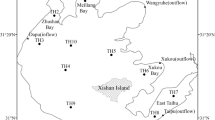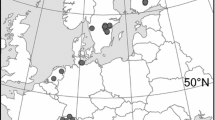Abstract
The global methane (CH4) emission of lakes is estimated at between 6 and 16 % of total natural CH4 emissions. However, these values have a high uncertainty due to the wide variety of lakes with important differences in their morphological, biological, and physicochemical parameters and the relatively scarse data from southern mid-latitude lakes. For these reasons, we studied CH4 fluxes and CH4 dissolved in water in a typical shallow lake in the Pampean Wetland, Argentina, during four periods of consecutive years (April 2011–March 2015) preceded by different rainfall conditions. Other water physicochemical parameters were measured and meteorological data were reported. We identified three different states of the lake throughout the study as the result of the irregular alternation between high and low rainfall periods, with similar water temperature values but with important variations in dissolved oxygen, chemical oxygen demand, water turbidity, electric conductivity, and water level. As a consequence, marked seasonal and interannual variations occurred in CH4 dissolved in water and CH4 fluxes from the lake. These temporal variations were best reflected by water temperature and depth of the Secchi disk, as a water turbidity estimation, which had a significant double correlation with CH4 dissolved in water. The mean CH4 fluxes values were 0.22 and 4.09 mg/m2/h for periods with low and high water turbidity, respectively. This work suggests that water temperature and turbidity measurements could serve as indicator parameters of the state of the lake and, therefore, of its behavior as either a CH4 source or sink.


Similar content being viewed by others
Abbreviations
- AT:
-
air temperature
- COD:
-
chemical oxygen demand
- EC:
-
water electrical conductivity normalized to 25 °C
- DO:
-
dissolved oxygen
- MF:
-
methane diffusive fluxes
- RF:
-
total monthly rainfall
- SPI-6:
-
Standardized Precipitation Index for a 6-month timescale
- WL:
-
water level
- WM:
-
methane dissolved in water
- WMe:
-
methane dissolved in water that is in equilibrium with the atmospheric methane concentration
- WT:
-
surface water temperature
- Z:
-
depth of the Secchi disk
References
APHA (1976). Standard methods for the examination of water and wastewater. Washington DC: American Public Health Association.
Bange, H. W. (2006). Nitrous oxide and methane in European coastal waters. Estuarine, Coastal and Shelf Science. doi:10.1016/j.ecss.2006.05.042.
Bange, H., Bergmann, K., Hansen, H. P., Kock, A., Koppe, R., Malien, F., & Ostrau, C. (2010). Dissolved methane during hypoxic events at the Boknis Eck time series station (Eckernförde Bay, SW Baltic Sea). Biogeosciences. doi:10.5194/bg-7-1279-2010.
Bastviken, D., Cole, J., Pace, M., & Tranvik, L. (2004). Methane emissions from lakes: dependence of lake characteristics, two regional assessments, and a global estimate. Global Biogeochemical Cycles. doi:10.1029/2004GB002238.
Bohn, V. Y., Delgado, A. L., Piccolo, M. C., & Perillo, G. M. (2016). Assessment of climate variability and land use effect on shallow lakes in temperate plains of Argentina. Environmental Earth Sciences. doi:10.1007/s12665-016-5569-6.
Borrel, G., Jézéquel, D., Biderre-Petit, C., Morel-Desrosiers, N., Morel, J. P., Peyret, P., Fonty, G., & Lehours, A. C. (2011). Production and consumption of methane in freshwater lake ecosystems. Research in Microbiology. doi:10.1016/j.resmic.2011.06.004.
Bousquet, P., Ciais, P., Miller, J. B., Dlugokencky, E. J., Hauglustaine, D. A., Prigent, C., et al. (2006). Contribution of anthropogenic and natural sources to atmospheric methane variability. Nature. doi:10.1038/nature05132.
Cano, M. G., Casco, M. A., & Claps, M. C. (2016). Epipelon dynamics in a shallow lake through a turbid-and a clear-water regime. Journal of Limnology. doi:10.4081/jlimnol.2016.1340.
Canziani, G., Ferrati, R., Marinelli, C., & Dukatz, F. (2008). Artificial neural networks and remote sensing in the analysis of the highly variable pampean shallow lakes. Mathematical Biosciences and Engineering. doi:10.3934/mbe.2008.5.691.
Cirelli, A. F., & Miretzky, P. (2004). Ionic relations: a tool for studying hydrogeochemical processes in Pampean shallow lakes (Buenos Aires, Argentina). Quaternary International. doi:10.1016/S1040-6182(03)00046-6.
Claps, M. C., Gabellone, N. A., & Benítez, H. H. (2004). Zooplankton biomass in an eutrophic shallow lake (Buenos Aires, Argentina): spatio-temporal variations. Annales de Limnologie - International Journal of Limnology. doi:10.1051/limn/2004018.
Deborde, J., Anschutz, P., Guérin, F., Poirier, D., Marty, D., Boucher, G., Thouzeau, G., Canton, M., & Abril, G. (2010). Methane sources, sinks and fluxes in a temperate tidal lagoon: the Arcachon lagoon (SW France). Estuarine, Coastal and Shelf Science. doi:10.1016/j.ecss.2010.07.013.
Denman, K. L., Brasseur, G., Chidthaisong, A., Ciais, P., Cox, P. M., Dickinson, R. E., Hauglustaine, D., Heinze, C., Holland, E., Jacob, D., Lohmann, U., Ramachandran, S., da Silva Dias, P. L., Wofsy, S. C., & Zhang, X. (2007). Couplings between changes in the climate system and biogeochemistry. In S. Solomon, D. Qin, M. Manning, Z. Chen, M. Marquis, K. B. Averyt, M. Tignor, & H. L. Miller (Eds.), Climate change 2007: the physical science basis. Contribution of working group I to the fourth assessment report of the intergovernmental panel on climate change (pp. 499–587). Cambridge: Cambridge University Press.
Díaz, O., & Colasurdo, V. (2008). Capítulo III: El agua revela sus secretos. Química de las lagunas pampeanas. In F. Grosman (Ed.), Espejos en la llanura. Nuestras lagunas de la región pampeana (pp. 119–127). Buenos Aires: Universidad Nacional del Centro de la Provincia de Buenos Aires.
Diovisalvi, N., Bohn, V. Y., Piccolo, M. C., Perillo, G. M., Baigún, C., & Zagarese, H. E. (2015). Shallow lakes from the Central Plains of Argentina: an overview and worldwide comparative analysis of their basic limnological features. Hydrobiologia. doi:10.1007/s10750-014-1946-x.
Dukatz, F. (2008). Capítulo IX: Nuestros ojos en el cielo: Los satélites de aplicación científica. In F. Grosman (Ed.), Espejos en la llanura. Nuestras lagunas de la región pampeana (pp. 119–127). Buenos Aires: Universidad Nacional del Centro de la Provincia de Buenos Aires.
Fonseca, A. L. S., Minello, M., Marinho, C. C., & Esteves, F. A. (2004). Methane concentration in water column and in pore water of a coastal lagoon (Cabiúnas lagoon, Macaé, RJ, Brazil). Brazilian Archives of Biology and Technology. doi:10.1590/S1516-89132004000200018.
Forster, P., Ramaswamy, V., Artaxo, P., Berntsen, T., Betts, R., Fahey, D. W., Haywood, J., Lean, J., Lowe, D. C., Myhre, G., Nganga, J., Prinn, R., Raga, G., M., S., & Van Dorland, R. (2007). Changes in atmospheric constituents and in radiative forcing. In S. Solomon, D. Qin, M. Manning, Z. Chen, M. Marquis, K. B. Averyt, M. Tignor, & H. L. Miller (Eds.), Climate change 2007: the physical science basis. Contribution of working group I to the fourth assessment report of the intergovernmental panel on climate change (pp. 129–234). Cambridge: Cambridge University Press.
Furlanetto, L. M., Marinho, C. C., Palma-Silva, C., Albertoni, E. F., Figueiredo-Barros, M. P., & de Assis Esteves, F. (2012). Methane levels in shallow subtropical lake sediments: dependence on the trophic status of the lake and allochthonous input. Limnologica - Ecology and Management of Inland Waters. doi:10.1016/j.limno.2011.09.009.
Gondwe, M. J., & Masamba, W. R. (2014). Spatial and temporal dynamics of diffusive methane emissions in the Okavango Delta, northern Botswana, Africa. Wetlands ecology and management. doi:10.1007/s11273-013-9323-5.
Guerra, L., Piovano, E. L., Córdoba, F. E., Sylvestre, F., & Damatto, S. (2015). The hydrological and environmental evolution of shallow Lake Melincué, central Argentinean Pampas, during the last millennium. Journal of Hydrology. doi:10.1016/j.jhydrol.2015.01.002.
Hem, J. D. (1985). Study and interpretation of the chemical characteristics of natural water. Washington: Department of the Interior, US Geological Survey.
Huarte, A., Cifuentes, V., Gratton, R., & Clausse, A. (2010). Correlation of methane emissions with cattle population in Argentine Pampas. Atmospheric Environment. doi:10.1016/j.atmosenv.2010.03.012.
Iriondo, M. (2004). Large wetlands of South America: a model for Quaternary humid environments. Quaternary International. doi:10.1016/S1040-6182(03)00037-5.
Kankaala, P., Ojala, A., & Käki, T. (2004). Temporal and spatial variation in methane emissions from a flooded transgression shore of a boreal lake. Biogeochemistry. doi:10.1023/B:BIOG.0000031030.77498.1f.
Le Mer, J., & Roger, P. (2001). Production, oxidation, emission and consumption of methane by soils: a review. European Journal of Soil Biology. doi:10.1016/S1164-5563(01)01067-6.
Li, T., Zhang, W., Zhang, Q., Lu, Y., Wang, G., Niu, Z., et al. (2015). Impacts of climate and reclamation on temporal variations in CH4 emissions from different wetlands in China: from 1950 to 2010. Biogeosciences. doi:10.5194/bgd-12-7055-2015.
Lopes, F., Viollier, E., Thiam, A., Michard, G., Abril, G., Groleau, A., Prévot, F., Carrias, J.-F., Albéric, P., & Jézéquel, D. (2011). Biogeochemical modelling of anaerobic vs. aerobic methane oxidation in a meromictic crater lake (Lake Pavin, France). Applied Geochemistry. doi:10.1016/j.apgeochem.2011.06.021.
Marani, L., & Alvalá, P. C. (2007). Methane emissions from lakes and floodplains in Pantanal, Brazil. Atmospheric Environment. doi:10.1016/j.atmosenv.2006.10.046.
Matthews, C. J., St. Louis, V. L., & Hesslein, R. H. (2003). Comparison of three techniques used to measure diffusive gas exchange from sheltered aquatic surfaces. Environmental Science & Technology. doi:10.1021/es0205838.
Ojala, A., Bellido, J. L., Tulonen, T., Kankaala, P., & Huotari, J. (2011). Carbon gas fluxes from a brown-water and a clear-water lake in the boreal zone during a summer with extreme rain events. Limnology and Oceanography. doi:10.4319/lo.2011.56.1.0061.
Ortiz-Llorente, M. J., & Alvarez-Cobelas, M. (2012). Comparison of biogenic methane emissions from unmanaged estuaries, lakes, oceans, rivers and wetlands. Atmospheric Environment. doi:10.1016/j.atmosenv.2012.05.031.
Quirós, R., & Drago, E. (1999). The environmental state of Argentinean lakes: an overview. Lakes & Reservoirs: Research and Management. doi:10.1046/j.1440-1770.1999.00076.x.
Ringeval, B., Noblet-Ducoudré, N., Ciais, P., Bousquet, P., Prigent, C., Papa, F., & Rossow, W. B. (2010). An attempt to quantify the impact of changes in wetland extent on methane emissions on the seasonal and interannual time scales. Global Biogeochemical Cycles. doi:10.1029/2008GB003354.
Sánchez, M. L., Lagomarsino, L., Allende, L., & Izaguirre, I. (2015). Changes in the phytoplankton structure in a Pampean shallow lake in the transition from a clear to a turbid regime. Hydrobiologia. doi:10.1007/s10750-014-2010-6.
Schrier-Uijl, A. P., Veraart, A. J., Leffelaar, P. A., Berendse, F., & Veenendaal, E. M. (2011). Release of CO2 and CH4 from lakes and drainage ditches in temperate wetlands. Biogeochemistry. doi:10.1007/s10533-010-9440-7.
Torremorell, A., Bustigorry, J., Escaray, R., & Zagarese, H. E. (2007). Seasonal dynamics of a large, shallow lake, laguna Chascomús: the role of light limitation and other physical variables. Limnologica - Ecology and Management of Inland Waters. doi: 10.1016/j.limno.2006.09.002Centro de investigaciones en Física e Ingeniería.
U.S. EPA Region 1 (2002). Technical guidance for the natural attenuation indicators: methane, ethane, and ethene. In Revisión 1. New England: EPA New England.
Vincent, W. F. (2010). Effects of climate change on lakes. In G. E. Likens (Ed.), Lake ecosystem ecology: a global perspective (pp. 65–71). New York: Academic Press.
Wan, Z., Zhang, Y., Zhang, Q., & Li, Z. L. (2002). Validation of the land-surface temperature products retrieved from Terra moderate resolution imaging spectroradiometer data. Remote Sensing of Environment. doi:10.1016/S0034-4257(02)00093-7.
Wiesenburg, D. A., & Guinasso Jr., N. L. (1979). Equilibrium solubilities of methane, carbon monoxide, hydrogen in water and seawater. Journal of Chemical and Engineering Data. doi:10.1021/je60083a006.
Wu, H., Hayes, M. J., Wilhite, D. A., & Svoboda, M. D. (2005). The effect of the length of record on the standardized precipitation index calculation. International Journal of Climatology. doi:10.1002/joc.1142.
Yang, S. S. (1998). Methane production in river and lake sediments in Taiwan. Environmental Geochemistry and Health. doi:10.1023/A:1006536820697.
Zhou, Y., Zhang, Y., Shi, K., Liu, X., & Niu, C. (2015). Dynamics of chromophoric dissolved organic matter influenced by hydrological conditions in a large, shallow, and eutrophic lake in China. Environmental Science and Pollution Research. doi:10.1007/s11356-015-4556-x.
Acknowledgments
Financial support was provided by the National Agency for Scientific and Technological Research (ANPCyT) of the Ministry of Science, Technology and Innovation (MINCyT), Argentina (PICT 2015-2540). The authors gratefully acknowledge the National Weather Service for meteorological data and Dr. Natasha Picone for her help with the SPI interpretation.
Author information
Authors and Affiliations
Corresponding author
Ethics declarations
Conflict of interest
The authors declare that they have no conflict of interest.
Additional information
Roberto Gratton is deceased 7 November 2014
Rights and permissions
About this article
Cite this article
Fusé, V.S., Priano, M.E., Williams, K.E. et al. Temporal variation in methane emissions in a shallow lake at a southern mid latitude during high and low rainfall periods. Environ Monit Assess 188, 590 (2016). https://doi.org/10.1007/s10661-016-5601-z
Received:
Accepted:
Published:
DOI: https://doi.org/10.1007/s10661-016-5601-z




